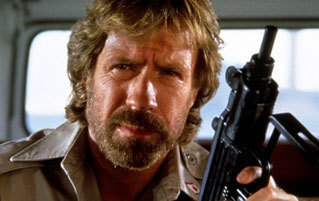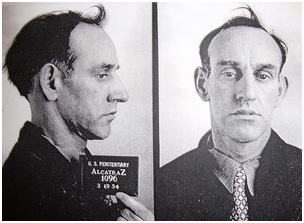6 Movies You Won't Believe Are Based on Insane True Stories

When we see movies, we tend to take the phrase "based on a true story" with a healthy amount of skepticism, because a lot of them turn out to be complete bullshit. However, some movies are inspired by true events that are so unrealistic, the filmmakers don't even bother telling us they actually happened, because we'd never believe them if they did. Did you know ...
50 First Dates -- A Real Woman Has Drew Barrymore's Bizarre Form of Amnesia

50 First Dates has a setup that seems exactly as realistic as, say, Liar Liar. Drew Barrymore plays a woman who, due to an accident, is afflicted with a wacky form of amnesia, so whenever she goes to sleep, all her recent memories are erased. Each day she wakes up thinking it's the day of her accident, leading to a series of contrived comedy misunderstandings.
Yes, despite the fact that she has to spend every single day rediscovering the fact that she is married to Adam Sandler, this movie is supposedly a comedy.

The True Story
There actually is a real-life woman with an ultra-rare form of anterograde amnesia, and as a result, for nearly 20 years Michelle Philpots has been completely unable to form new memories. She has to use a deck of Post-it notes just to get through her day-to-day life.

She is presumably also tattooed with cryptic sentence fragments and out for revenge.
Philpots was in a bad motorcycle accident in 1985 and an equally severe car accident in 1990, and her resulting injuries did enough cumulative brain damage that she started suffering from seizures and was diagnosed with epilepsy. By 1994, Philpots had completely lost the ability to retain any short-term memories, and she now has no recollection of anything that has happened for the past two decades. Which means that she starts off every single day believing it is still 1994.

Philpots is also married, so much like in 50 First Dates, her husband has to remind her of their union every time she wakes up by showing her their wedding album. Luckily, the two had already been dating for several years before Philpots' amnesia developed, so unlike Drew Barrymore, she isn't waking up every morning next to a total stranger (who is also Adam Sandler).
Heat -- Neil McCauley Actually Had Coffee With the Cop Pursuing Him

The 1995 Tom Sizemore charity film Heat starred Robert De Niro as master thief Neil McCauley and Al Pacino as Vincent Hanna, a guy who yells a lot about his television set. Hanna also happens to be a police detective relentlessly pursuing McCauley, and right before shooting the shit out of LA with assault rifles, they get together in a diner to shoot the shit over a cup of coffee.

It's a cool scene -- the good guy and the bad guy sizing each other up during a tense but cordial public meeting -- but there's no way anything like that would ever happen in real life, right? A bank robber wouldn't sit down in a Denny's to talk shop with the cop who is trying to throw him in jail for the rest of his life, when anything said can directly lead to an arrest (and testimony) down the line. That's something a stupid person would do.
The True Story
Believe it or not, the coffee shop scene in Heat is entirely based on reality.
You see, De Niro's character in the film is based on a real guy named Neil McCauley, a career criminal with an extensive history of robbery. The man did seven years in freaking Alcatraz with an Alfalfa cowlick, so you know he's hardcore.

Either that, or these are stills from the gritty reboot of Our Gang.
As McCauley continued to pull off big scores with his crew of fellow thieves, he was being pursued by a Chicago police officer named Chuck Adamson. And while pursuing McCauley, Adamson really did sit down to have a cup of coffee with him, over which they discussed their opposing lifestyles and made thinly veiled verbal threats. Even though the two men were brutal enemies who would not hesitate to shoot life-ending bullets into each other's faces, they also shared a mutual respect not unlike Magneto and Professor Charles Xavier.
Also, just like in the movie, the real-life McCauley did indeed abort a heist mid-operation after catching on that the cops were watching, and Adamson was forced to kill him after a robbery, a chase, and an epic shootout. However, it is unclear whether they held hands after their ultimate bro-down like their big screen counterparts.

We think McCauley made out better than De Niro, because Little Fockers is a fate worse than death.
Adamson later went into television production and became friends with Michael Mann, the guy who directed Heat. Mann wound up borrowing a lot of details from Adamson's career of chasing McCauley for his crime epic, including modeling the character of Vincent Hanna after Adamson, presumably asking Al Pacino to embrace Adamson's nuances and subtleties with the howlingly bug-eyed restraint he is known for.

The Blob -- Based on an Actual Police Report

The 1958 sci-fi horror classic The Blob is about a rural Pennsylvania town being terrorized by the titular Blob, a giant gelatinous breast implant from outer space that keeps growing bigger and bigger the more people it consumes. It is also notable for starring Steve McQueen as a high school student, despite the fact that he is clearly almost 30 years old in the film.

The True Story
Believe it or not, The Blob is based on an incident in the 1950s when Philadelphia policemen stumbled upon a quivering purple lump that had crash landed in a nearby field, as if Grimace had suddenly been stricken with bubblegut in the middle of a hang gliding trip. According to the responding officers, the mass was like a giant glowing jelly ball, and it left a sticky residue when touched, because of course the first thing you would do when encountering a mysterious Plutonian blob is shove your hands into it.

The two cops wanted witnesses to corroborate what they were seeing, so they radioed for two fellow officers to come take a look at it, if for no other reason than to prove they hadn't just been pranked by a couple of hopheads and alkies with 50 jars of Smuckers and absolutely nothing better to do. The blob quickly began to fall apart, and within half an hour had completely dissolved, leaving behind no trace that it had ever existed. Regardless of how ridiculous the story may seem, an official government report was made of the incident, although that likely had more to do with the Cold War than a fear of extraterrestrial preserves.

Who knows what it actually was -- maybe some passing pedestrian dropped a Jell-O mold and, before the officers could come back to the scene, some passing animal came and ate it. Or maybe the guy just made the whole thing up.
Either way, years later a man named Irvine H. Millgate (who at one point in his life had the very unique job title of "Head of Visual Aids for the Boy Scouts of America") needed to come up with a premise for a low-budget monster movie, but instead of pulling something completely out of his ass, he remembered the 1950 Philadelphia incident and used it as inspiration to assist him in pulling something completely out of his ass. The Blob became an unlikely hit, so if that purple blob creature actually returns to Earth someday, we assume the first thing it's going to do is sue for unpaid royalties (and then get shot by Tom Cruise).

A Few Good Men -- The Real Story Is Actually More Terrifying

A Few Good Men is best known as the movie wherein Jack Nicholson doesn't believe that Tom Cruise is capable of handling the truth.

Cruise plays a Navy lawyer defending two U.S. Marines who accidentally killed a fellow Marine while hazing him under orders from Nicholson, their commanding officer. In the end, Cruise finally goads Nicholson into admitting that he ordered the hazing by employing the brilliant legal tactic of "getting him so pissed that he confesses to a crime in open court."

The True Story
The movie was written by Aaron Sorkin, who originally got the idea for the story from his sister, a JAG Corps officer (as seen in the television docudrama JAG) who had been assigned to help defend a group of Marines who had performed a "code red" hazing on a fellow Marine and nearly killed him. One of the Marines involved in the hazing was PFC David Cox, a man with a fairly horrifying face:

Much like the character of Private Downey in the film, Cox didn't believe he had done anything wrong, because he had only been following the orders of his superior officers. In the end, Cox was only convicted of the relatively minor charge of simple assault and later received an honorable discharge. He lived a normal civilian life for the next few years, until he went to see A Few Good Men and thought it looked awfully familiar, because apparently Kevin Bacon had also been the prosecuting attorney at his trial.

Cox and some of the other defendants decided to organize a lawsuit against the production company for using their story without permission, despite the fact that the movie is a fictionalized version of the event that doesn't use any real names and at no point represents itself as a true story. In the wake of his litigation preparation, Cox gave a series of angry radio interviews, decrying not only A Few Good Men but also the true-life "code red" incident that had inspired it.
And that's when things got really creepy.
In January 1994, David Cox mysteriously disappeared from his home in Medfield, Massachusetts (he literally vanished -- his car and all his things were still at the apartment). Three months later, his bullet-soaked body was found in a remote wooded area between two gun ranges. To this day nobody knows what happened. We don't even want to speculate, we don't want these people mad at us.

The hit 1990 film The Hunt for Red October stars Sean Connery as Marko Ramius, the world's only Lithuanian submarine commander with a Scottish accent. Ramius is the captain of a high-tech Soviet submarine called Red October, and during a routine training exercise, he decides to steal Red October and flee to America, supposedly to launch a nuclear strike against the United States. However, Ramius ends up defecting to America instead, faking his death and handing the Red October over to the U.S. Navy and Alec Baldwin.

The subterfuge results in the death of Sam Neill, Ramius' first officer and best friend, but in exchange Ramius gets to live out the rest of his days as a free man on American soil. After all, it's not like he could've just waited around another year for the Soviet Union to fall and then bought a plane ticket to Washington, D.C. What are the odds of that happening?
The True Story
The Hunt for Red October was based on a book by Tom Clancy, who in turn was inspired by a true story of a mutiny on a Soviet destroyer called the Sentry, orchestrated by Captain Valery Sablin. Sablin felt the Soviet Union wasn't communist enough for his tastes and decided to hijack his own vessel to storm Leningrad and stage another revolution, which seems to suggest that either the Sentry was packing some serious heat or the strength of the Soviet military was dramatically overestimated during the Cold War.

Sablin took control of his ship by locking up its command crew (Sablin was a captain, but he wasn't the captain, sort of like Liam Neeson in K-19: The Widowmaker) and relying only on a small contingent of men loyal to him to run the vessel. However, a junior officer managed to escape and radio for help, and much like in Red October, Moscow's response was to stop the Sentry at all costs, even if it meant reducing the ship and all those on board to treasonous dust. The Sentry was eventually disabled by Soviet gunships and planes, and Sablin was executed.
At the time that Clancy wrote his novel in the early 1980s, the Soviet Union was still in full effect, and their official story was that Sablin staged the mutiny in order to escape to Sweden and defect to the West (there's even a scene in the book where Alec Baldwin's character briefly references Sablin in order to back up his theory that Marko Ramius is defecting). However, after the Cold War ended, it was revealed that the original story about Sablin's defection was bullshit, and that he was, in fact, trying to drive his stolen death boat up to Leningrad. So due to an unusual chain of events, The Hunt for Red October was based on a partially fictionalized account of something that really happened. Had the full story been released when Clancy was writing his novel, the movie might have had a very different ending.

The Delta Force -- A Chuck Norris-ed Version of a Real Hijacking

The Delta Force is a Chuck Norris action film from the 1980s, which is arguably the most redundant qualifying sentence in history. A commercial airliner is hijacked by evil Middle Eastern terrorists, and only Chuck Norris and his motorcycle can stop them.

The True Story
The Delta Force was heavily inspired by the real-life hijacking of TWA Flight 847 in June of 1985, and by "heavily inspired" we mean "virtually a scene-for-scene re-enactment."

Especially all the Chuck Norris parts. Those are totally true.
The plane was taken over by terrorists while en route from Athens to Rome, just like in the movie, and the rest of the film's first half is a surprisingly faithful recreation of the TWA incident. For example, in The Delta Force, the hijackers demand that the Jewish passengers be separated from the rest of the hostages and force a German flight attendant to sort through the passports to pick out the Jewish names, apparently because they assumed that all Germans are Nazis and are good at that sort of thing. The hijackers did the exact same thing in real life to German flight purser Uli Derickson (who had a separate TV movie made about her a few years later). Rather than do what they asked, she hid all the passports and claimed she couldn't find them.

The terrorists on the TWA flight executed an American Navy diver named Robert Stethem by brutally beating him with an armrest, shooting him, and dumping his body onto a runway. The exact same thing happens in The Delta Force:

One of the most iconic images from the TWA hijacking was of the pilot delivering a forced statement to the media with his armed captor clearly visible over his shoulder:

Once again, this detail is totally repeated in the movie:

The only real difference between The Delta Force and the real-life TWA hijacking is the way the stories end. You see, the TWA hostages were gradually released over the course of a few weeks and the hijackers got away. One of them was eventually arrested a few years later, but still, that's pretty anticlimactic. So rather than make a straightforward drama about Flight 847, Hollywood decided to engage in wish fulfillment revenge fantasy and ask the ultimate question: "What if Chuck Norris had been there?"

It's obviously the ending America wanted in real life -- Chuck Norris and the Delta Force heroically eliminate all the terrorists and free the hostages, and everyone drinks beer and sings "America the Beautiful" on the plane ride home.

We're not kidding. This is actually how the movie ends.
Robin Warder is the co-owner of a pop culture website called The Back Row and was recently involved in the making of a sci-fi short film called Jet Ranger of Another Tomorrow.
Related Reading: These aren't the only true stories too badass for film. The man who stopped a burglar with chili-powder punches still hasn't made it to the silver screen. Even horror movies have been topped by the real world, these Swedish twins who flipped out simultaneously haven't even been equaled by Japan. Need more unbelievably true stories? Right here, buddy.
